2003 CHEVROLET EXPRESS CARGO VAN weight
[x] Cancel search: weightPage 231 of 386
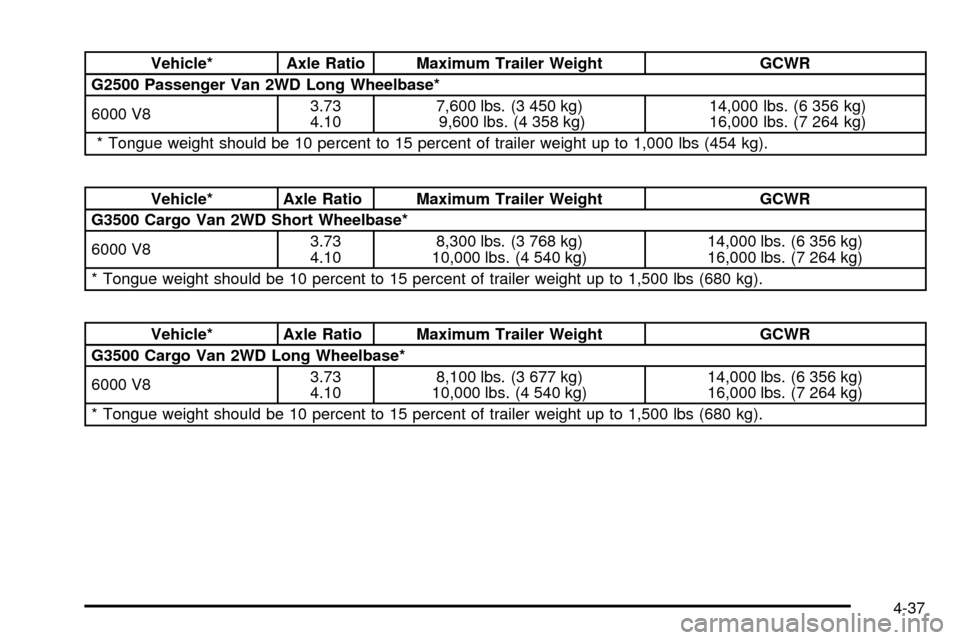
Vehicle* Axle Ratio Maximum Trailer Weight GCWR
G2500 Passenger Van 2WD Long Wheelbase*
6000 V83.73
4.107,600 lbs. (3 450 kg)
9,600 lbs. (4 358 kg)14,000 lbs. (6 356 kg)
16,000 lbs. (7 264 kg)
* Tongue weight should be 10 percent to 15 percent of trailer weight up to 1,000 lbs (454 kg).
Vehicle* Axle Ratio Maximum Trailer Weight GCWR
G3500 Cargo Van 2WD Short Wheelbase*
6000 V83.73
4.108,300 lbs. (3 768 kg)
10,000 lbs. (4 540 kg)14,000 lbs. (6 356 kg)
16,000 lbs. (7 264 kg)
* Tongue weight should be 10 percent to 15 percent of trailer weight up to 1,500 lbs (680 kg).
Vehicle* Axle Ratio Maximum Trailer Weight GCWR
G3500 Cargo Van 2WD Long Wheelbase*
6000 V83.73
4.108,100 lbs. (3 677 kg)
10,000 lbs. (4 540 kg)14,000 lbs. (6 356 kg)
16,000 lbs. (7 264 kg)
* Tongue weight should be 10 percent to 15 percent of trailer weight up to 1,500 lbs (680 kg).
4-37
Page 232 of 386
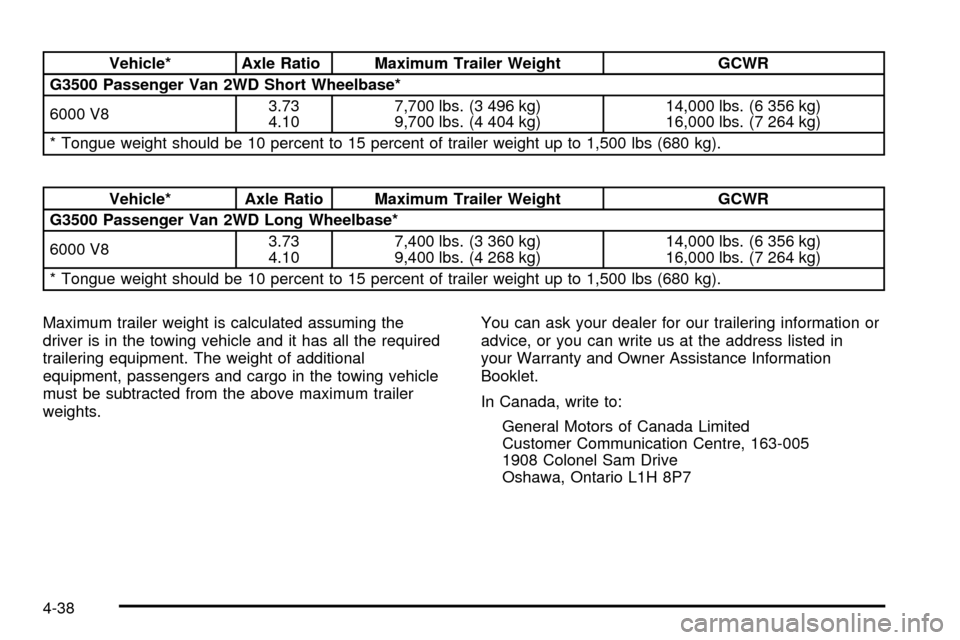
Vehicle* Axle Ratio Maximum Trailer Weight GCWR
G3500 Passenger Van 2WD Short Wheelbase*
6000 V83.73
4.107,700 lbs. (3 496 kg)
9,700 lbs. (4 404 kg)14,000 lbs. (6 356 kg)
16,000 lbs. (7 264 kg)
* Tongue weight should be 10 percent to 15 percent of trailer weight up to 1,500 lbs (680 kg).
Vehicle* Axle Ratio Maximum Trailer Weight GCWR
G3500 Passenger Van 2WD Long Wheelbase*
6000 V83.73
4.107,400 lbs. (3 360 kg)
9,400 lbs. (4 268 kg)14,000 lbs. (6 356 kg)
16,000 lbs. (7 264 kg)
* Tongue weight should be 10 percent to 15 percent of trailer weight up to 1,500 lbs (680 kg).
Maximum trailer weight is calculated assuming the
driver is in the towing vehicle and it has all the required
trailering equipment. The weight of additional
equipment, passengers and cargo in the towing vehicle
must be subtracted from the above maximum trailer
weights.You can ask your dealer for our trailering information or
advice, or you can write us at the address listed in
your Warranty and Owner Assistance Information
Booklet.
In Canada, write to:
General Motors of Canada Limited
Customer Communication Centre, 163-005
1908 Colonel Sam Drive
Oshawa, Ontario L1H 8P7
4-38
Page 233 of 386

Weight of the Trailer Tongue
The tongue load (A) of any trailer is an important weight
to measure because it affects the total or gross weight of
your vehicle. The Gross Vehicle Weight (GVW) includes
the curb weight of the vehicle, any cargo you may carry in
it, and the people who will be riding in the vehicle. And if
you will tow a trailer, you must add the tongue load to the
GVW because your vehicle will be carrying that weight,
too. See
Loading Your Vehicle on page 4-29about your
vehicle's maximum load capacity.
If you're using a weight-carrying or a weight-distributing
hitch, the trailer tongue weight (A) should be 10 percent
to 15 percent of the total loaded trailer weight (B).Do not exceed the maximum allowable tongue weight
for your vehicle.
After you've loaded your trailer, weigh the trailer and then
the tongue, separately, to see if the weights are proper. If
they aren't, you may be able to get them right simply by
moving some items around in the trailer.
Total Weight on Your Vehicle's Tires
Be sure your vehicle's tires are in¯ated to the upper limit
for cold tires. You'll ®nd these numbers on the
Certi®cation label at the rear edge of the driver's door or
see
Loading Your Vehicle on page 4-29. Then be
sure you don't go over the GVW limit for your vehicle,
including the weight of the trailer tongue.
Hitches
It's important to have the correct hitch equipment.
Crosswinds, large trucks going by and rough roads are
a few reasons why you'll need the right hitch. Here
are some rules to follow:
·The bumpers on your vehicle are not intended for
hitches. Do not attach rental hitches or other
bumper-type hitches to them. Use only a
frame-mounted hitch that does not attach to the
bumper. Do not use a ball hitch, because it could
pull the bumper loose.
4-39
Page 234 of 386
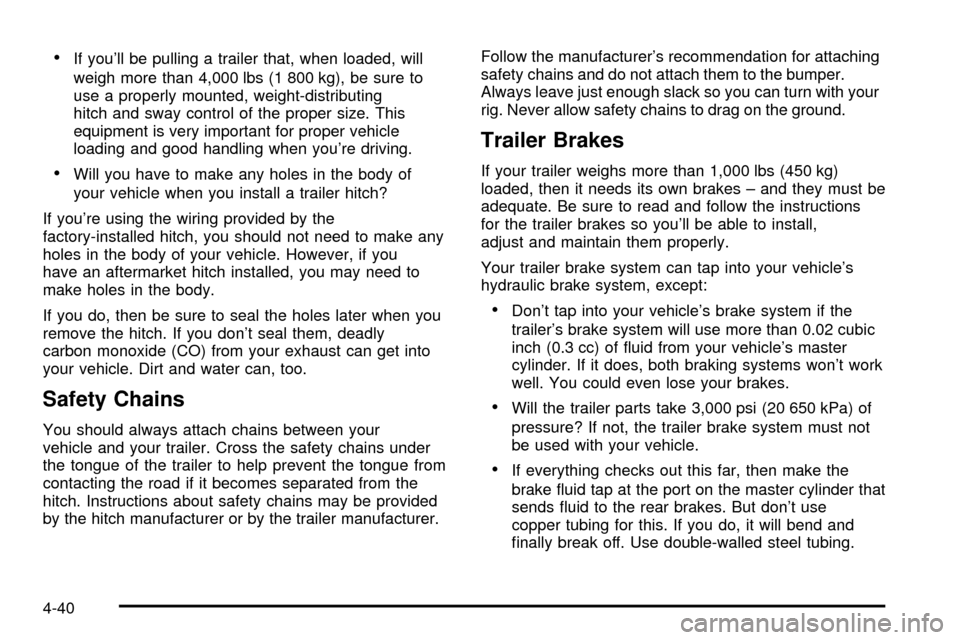
·If you'll be pulling a trailer that, when loaded, will
weigh more than 4,000 lbs (1 800 kg), be sure to
use a properly mounted, weight-distributing
hitch and sway control of the proper size. This
equipment is very important for proper vehicle
loading and good handling when you're driving.
·Will you have to make any holes in the body of
your vehicle when you install a trailer hitch?
If you're using the wiring provided by the
factory-installed hitch, you should not need to make any
holes in the body of your vehicle. However, if you
have an aftermarket hitch installed, you may need to
make holes in the body.
If you do, then be sure to seal the holes later when you
remove the hitch. If you don't seal them, deadly
carbon monoxide (CO) from your exhaust can get into
your vehicle. Dirt and water can, too.
Safety Chains
You should always attach chains between your
vehicle and your trailer. Cross the safety chains under
the tongue of the trailer to help prevent the tongue from
contacting the road if it becomes separated from the
hitch. Instructions about safety chains may be provided
by the hitch manufacturer or by the trailer manufacturer.Follow the manufacturer's recommendation for attaching
safety chains and do not attach them to the bumper.
Always leave just enough slack so you can turn with your
rig. Never allow safety chains to drag on the ground.
Trailer Brakes
If your trailer weighs more than 1,000 lbs (450 kg)
loaded, then it needs its own brakes ± and they must be
adequate. Be sure to read and follow the instructions
for the trailer brakes so you'll be able to install,
adjust and maintain them properly.
Your trailer brake system can tap into your vehicle's
hydraulic brake system, except:
·Don't tap into your vehicle's brake system if the
trailer's brake system will use more than 0.02 cubic
inch (0.3 cc) of ¯uid from your vehicle's master
cylinder. If it does, both braking systems won't work
well. You could even lose your brakes.
·Will the trailer parts take 3,000 psi (20 650 kPa) of
pressure? If not, the trailer brake system must not
be used with your vehicle.
·If everything checks out this far, then make the
brake ¯uid tap at the port on the master cylinder that
sends ¯uid to the rear brakes. But don't use
copper tubing for this. If you do, it will bend and
®nally break off. Use double-walled steel tubing.
4-40
Page 235 of 386

Driving with a Trailer
{CAUTION:
If you have a rear-most window open and you
pull a trailer with your vehicle, carbon
monoxide (CO) could come into your vehicle.
You can't see or smell CO. It can cause
unconsciousness or death. See ªEngine
Exhaustº in the Index. To maximize your safety
when towing a trailer:
·Have your exhaust system inspected for
leaks, and make necessary repairs before
starting on your trip.
·Keep the rear-most windows closed.
·If exhaust does come into your vehicle
through a window in the rear or another
opening, drive with your front, main
heating or cooling system on and with the
fan on any speed. This will bring fresh,
outside air into your vehicle. Do not use
the climate control setting for maximum air
because it only recirculates the air inside
your vehicle. See ªClimate Controlsº in
the Index.Towing a trailer requires a certain amount of experience.
Before setting out for the open road, you'll want to get
to know your rig. Acquaint yourself with the feel of
handling and braking with the added weight of the trailer.
And always keep in mind that the vehicle you are
driving is now a good deal longer and not nearly as
responsive as your vehicle is by itself.
Before you start, check the trailer hitch and platform
(and attachments), safety chains, electrical connector,
lamps, tires and mirror adjustment. If the trailer has
electric brakes, start your vehicle and trailer moving and
then apply the trailer brake controller by hand to be
sure the brakes are working. This lets you check your
electrical connection at the same time.
During your trip, check occasionally to be sure that the
load is secure, and that the lamps and any trailer
brakes are still working.Following Distance
Stay at least twice as far behind the vehicle ahead as
you would when driving your vehicle without a trailer.
This can help you avoid situations that require
heavy braking and sudden turns.
4-41
Page 319 of 386
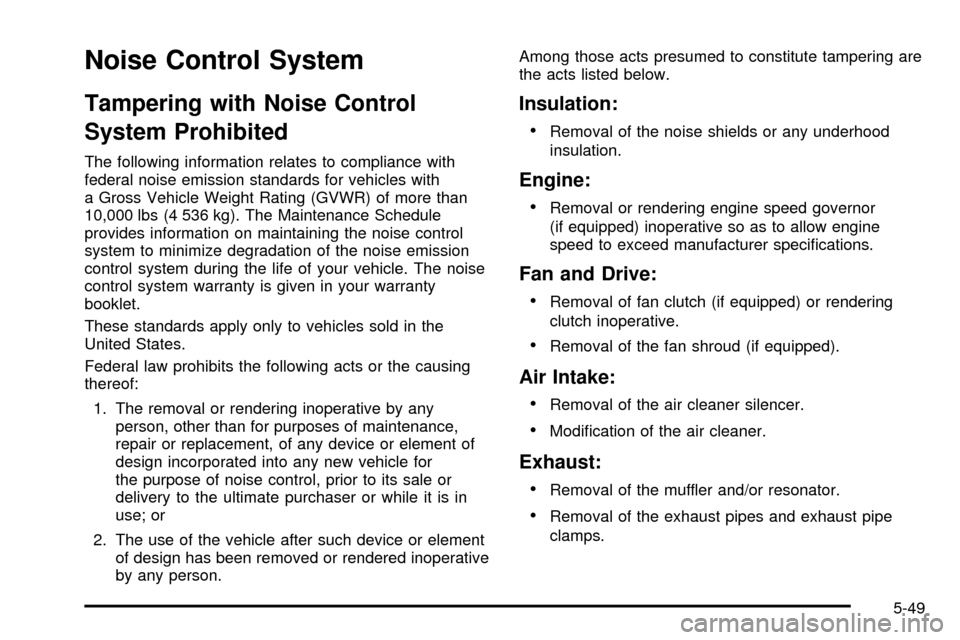
Noise Control System
Tampering with Noise Control
System Prohibited
The following information relates to compliance with
federal noise emission standards for vehicles with
a Gross Vehicle Weight Rating (GVWR) of more than
10,000 lbs (4 536 kg). The Maintenance Schedule
provides information on maintaining the noise control
system to minimize degradation of the noise emission
control system during the life of your vehicle. The noise
control system warranty is given in your warranty
booklet.
These standards apply only to vehicles sold in the
United States.
Federal law prohibits the following acts or the causing
thereof:
1. The removal or rendering inoperative by any
person, other than for purposes of maintenance,
repair or replacement, of any device or element of
design incorporated into any new vehicle for
the purpose of noise control, prior to its sale or
delivery to the ultimate purchaser or while it is in
use; or
2. The use of the vehicle after such device or element
of design has been removed or rendered inoperative
by any person.Among those acts presumed to constitute tampering are
the acts listed below.
Insulation:
·
Removal of the noise shields or any underhood
insulation.
Engine:
·
Removal or rendering engine speed governor
(if equipped) inoperative so as to allow engine
speed to exceed manufacturer speci®cations.
Fan and Drive:
·
Removal of fan clutch (if equipped) or rendering
clutch inoperative.
·Removal of the fan shroud (if equipped).
Air Intake:
·
Removal of the air cleaner silencer.
·Modi®cation of the air cleaner.
Exhaust:
·
Removal of the muffler and/or resonator.
·Removal of the exhaust pipes and exhaust pipe
clamps.
5-49
Page 384 of 386
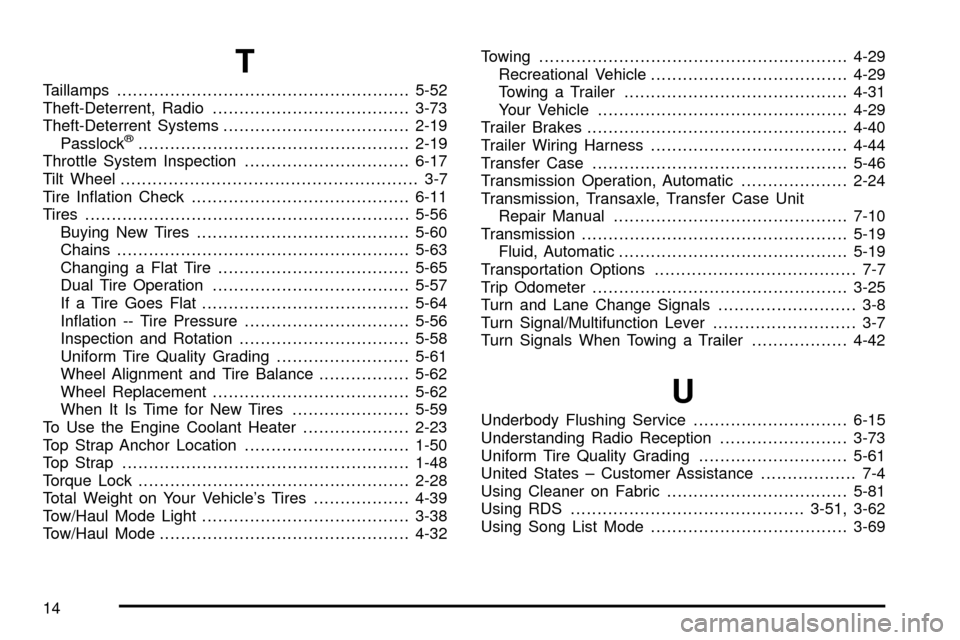
T
Taillamps.......................................................5-52
Theft-Deterrent, Radio.....................................3-73
Theft-Deterrent Systems...................................2-19
Passlock
ž...................................................2-19
Throttle System Inspection...............................6-17
Tilt Wheel........................................................ 3-7
Tire In¯ation Check.........................................6-11
Tires.............................................................5-56
Buying New Tires........................................5-60
Chains.......................................................5-63
Changing a Flat Tire....................................5-65
Dual Tire Operation.....................................5-57
If a Tire Goes Flat.......................................5-64
In¯ation -- Tire Pressure...............................5-56
Inspection and Rotation................................5-58
Uniform Tire Quality Grading.........................5-61
Wheel Alignment and Tire Balance.................5-62
Wheel Replacement.....................................5-62
When It Is Time for New Tires......................5-59
To Use the Engine Coolant Heater....................2-23
Top Strap Anchor Location...............................1-50
Top Strap......................................................1-48
Torque Lock...................................................2-28
Total Weight on Your Vehicle's Tires..................4-39
Tow/Haul Mode Light.......................................3-38
Tow/Haul Mode...............................................4-32Towing..........................................................4-29
Recreational Vehicle.....................................4-29
Towing a Trailer..........................................4-31
Your Vehicle...............................................4-29
Trailer Brakes.................................................4-40
Trailer Wiring Harness.....................................4-44
Transfer Case................................................5-46
Transmission Operation, Automatic....................2-24
Transmission, Transaxle, Transfer Case Unit
Repair Manual............................................7-10
Transmission..................................................5-19
Fluid, Automatic...........................................5-19
Transportation Options...................................... 7-7
Trip Odometer................................................3-25
Turn and Lane Change Signals.......................... 3-8
Turn Signal/Multifunction Lever........................... 3-7
Turn Signals When Towing a Trailer..................4-42
U
Underbody Flushing Service.............................6-15
Understanding Radio Reception........................3-73
Uniform Tire Quality Grading............................5-61
United States ± Customer Assistance.................. 7-4
Using Cleaner on Fabric..................................5-81
Using RDS............................................3-51, 3-62
Using Song List Mode.....................................3-69
14
Page 385 of 386
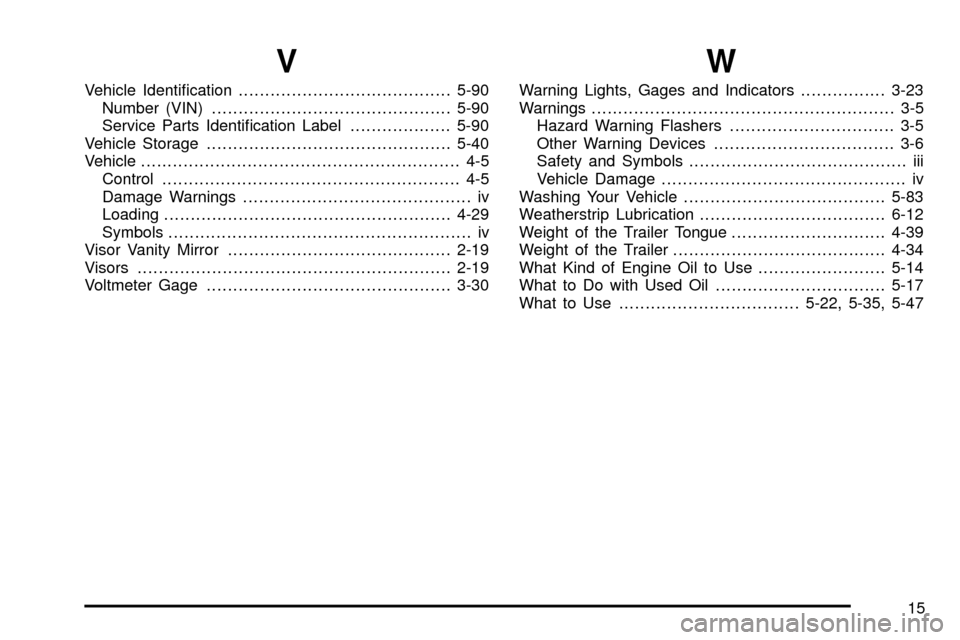
V
Vehicle Identi®cation........................................5-90
Number (VIN).............................................5-90
Service Parts Identi®cation Label...................5-90
Vehicle Storage..............................................5-40
Vehicle............................................................ 4-5
Control........................................................ 4-5
Damage Warnings........................................... iv
Loading......................................................4-29
Symbols......................................................... iv
Visor Vanity Mirror..........................................2-19
Visors...........................................................2-19
Voltmeter Gage..............................................3-30
W
Warning Lights, Gages and Indicators................3-23
Warnings......................................................... 3-5
Hazard Warning Flashers............................... 3-5
Other Warning Devices.................................. 3-6
Safety and Symbols......................................... iii
Vehicle Damage.............................................. iv
Washing Your Vehicle......................................5-83
Weatherstrip Lubrication...................................6-12
Weight of the Trailer Tongue.............................4-39
Weight of the Trailer........................................4-34
What Kind of Engine Oil to Use........................5-14
What to Do with Used Oil................................5-17
What to Use..................................5-22, 5-35, 5-47
15